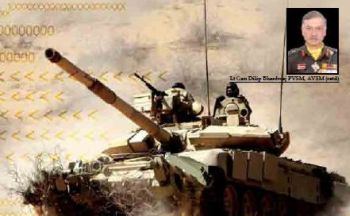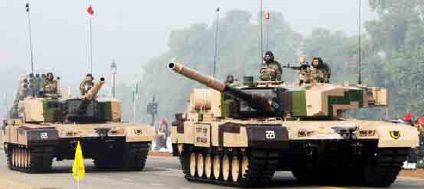“If the tank succeeds: Victory follows” – Heinz Guderian
In the days of yore, heavy cavalry was the arm of decision as it performed a function no other arm could – to break the will of the enemy to resist by their sheer speed, surprise and ferocity of attack. Captains of war would hold their heavy cavalry back to be unleashed at the decisive moment and point of application to ensure victory. No other arm enjoyed such supremacy in the battlefield hence cavalry was always revered and placed on a pedestal. During World War I, the stalemate of trench warfare was broken with the introduction of the tank on the battlefield and with the demise of the horse cavalry it was only natural for the cavalry to man the tanks. Tank battles of World War II are legendary and tanks evolved into a mean fighting machine and gave birth to the all arms concept.
This article is published with the kind permission of “Defence and Security Alert (DSA) Magazine” New Delhi-India
 |
In India the euphoria of Independence had not yet sunk in when the Indian Army, in October 1947, was called upon to push back the “raiders” from Pakistan, in Kashmir. During the operations armour was employed in the dizzying heights of Zojila Pass (11,400 ft) where our Stuart tanks were transported piece-meal, reassembled and thereafter conducted operations with devastating effect. Tanks were also employed in support of infantry in the Rajouri sector, however in both these sectors employment was limited due to constraints of equipment. During the 1962 operations, two armoured regiments were sent to the eastern borders, but saw little or no action. It was only in 1965 that the armoured corps proved its mettle and blunted the much touted thrust of Pakistan armour spearheaded by Patton tanks to create their “graveyard” at Khem Karan in Punjab and in turn launch the counter-offensive in the Sialkot sector. In both these sectors the Centurion tanks proved their superiority supported by the Sherman (up-gunned) tanks manned by better trained crews.
Since the demise of the cold war most countries have concentrated on upgrading their existing tank fleet to meet their operational requirement. During the past two decades only Russia (T‑90S), France (Leclerc), South Korea (M‑2) and India (Arjun) introduced new MBT’s. However from the lessons learnt from their war’s in Iraq, the US embarked on their Future Combat Systems (FCS) and the UK on their Future Rapid Effect Systems (FRES) programmes
 |
During the intervening years T‑54 / T‑55 / PT-76 and Vijayanta tanks entered service and hence in 1971 the Corps played a major and decisive role in the liberation of the Bangladesh and the bloody battles in the Shakargarh bulge, in the western sector.
An analysis of all these battles as regards the mechanised forces brings out the following pertinent points:
- Wars are won by the side which has a decisive competitive edge with regards to quality of equipment.
- For armour to be fully exploited it must suit the terrain in which it is employed.
- Due to the vast and varied terrain configuration along our borders specialised equipment, pre-positioned, gives disproportionate advantage.
- Armour must be employed concentrated and used boldly. Holding back large reserves at every level will ensure that the majority do not participate in the operations.
- There is no substitute to a well trained tank crew.
Geo-strategic environment
India’s rising status as a regional / super power makes it an important pillar of stability within the region. However to maintain and further this status we must take into consideration the changing geo-strategic environment and emerging security challenges which will entail expanding our sphere of influence to protect and further our interests in the Indian Ocean Region (IOR) and even beyond. Geo-strategic compulsions may dictate tasks for Out of Area Contingencies (OOAC) which could be supportive, interventionist, or preventive in design. The key geo-strategic challenges emanate from the ongoing conflict in Afghanistan and the unresolved territorial disputes along our northern borders with China as also against Pakistan. With the collaboration between China and Pakistan getting stronger by the day there is a high probability that the next conflict on the Indian sub-continent would breakout in the mountains first before expanding to the plains sector. The need is thus well established to evolve a strategy and force capability for the mechanised forces to remain ready and relevant from the point of view of our national aspirations and the dynamics of the future geo-strategic environment. This mandates a threat cum capability based approach for our force restructuring that would ensure it is capable of performing its task in diverse terrain. Obviously one size fits all concept is not possible and therefore we would in the future need different types of tanks and infantry fighting vehicles to be able to perform their operational task.
Operational scenario
The Armed Forces doctrine enunciates that they are to be prepared to conduct operations form a “Cold Start” along the western front and yet be prepared for a simultaneous two front war. Whereas the mechanised forces have the requisite capability to conduct successful operations along the western front, along the northern borders it is more dissuasive in nature. Dissuasion needs to be converted to a deterrent capability which would require an augmentation in the capability and versatility of the equipment.
In any future conflict the bulk of the mechanised forces will be facing the western border. With the “greening” of our immediate borders future battles are likely to be fought in terrain akin to the developed sector whilst seeking high value targets in a limited time frame. Mechanised forces would, therefore, need to adapt to fighting in built-up areas with a high density of vegetation and water channels. Therefore the present and the future generation AFV’s would have to be equipped with urban fighting and survival kits. Along our northern borders there is an inescapable need of greater strategic and tactical mobility for AFV’s to be able to switch axes along the valleys which have no lateral connection. Due to the slow rate of the development of infrastructure along the northern borders it is a logistic nightmare to deploy an MBT in these areas as they have to be air lifted in sections and re-assembled, tested and thereafter deployed. Once deployed the problem of tactical mobility arises. Therefore there is an inescapable need of deploying a limited number of wheeled light tanks which can be gainfully employed to initially blunt any offensive at the border itself gaining time for the heavy forces to build-up. Wheeled tanks can also be employed in OOAC operations which in the foreseeable future is a reality. With the eastern border and the riverine tract of our western borders getting active, the light tank is an operational necessity which would provide the strategic commander a means of gaining the initiative with deep outflanking manoeuvres over difficult terrain. The current generation of light tanks have the desired fire power of a 105 mm / 120 mm gun and the ability to fire a missile through the barrel of the gun. Survivability is enhanced with the fitment of the Active Defence Suit (ADS) and the Explosive Reactive Armour (ERA) panels. This versatile weapon system would provide the operational commander multiple options to execute his task.
Global trends
Since the demise of the cold war most countries have concentrated on upgrading their existing tank fleet to meet their operational requirement. During the past two decades only Russia (T‑90S), France (Leclerc), South Korea (M‑2) and India (Arjun) introduced new MBT’s. However from the lessons learnt from their wars in Iraq, the US embarked on their Future Combat Systems (FCS) and the UK on their Future Rapid Effect Systems (FRES) programmes.
The FCS modernisation programme was evolved on the concept of homogenous brigade combat teams. Based on the premise that wars in the future would be expeditionary in nature the intention was to ensure that an integrated family of systems were deployed in a massed effect to fight jointly on arrival in a matter of 72–96 hours anywhere in the world. To ensure strategic mobility the family of vehicles (wheeled and tracked) are lighter, equally lethal, air transportable to initially engage the enemy … before the heavier forces were inducted. As a start the Stryker ICV was developed followed by M‑1128 Mobile Gun System (MGS), based on the same wheeled chassis with a 105 mm gun. The role of the MGS was not only to engage other AFV’s, but also to neutralise battle field targets and support their infantry. The MGS was successfully deployed in Iraq in 2003. However, in Afghanistan all nations of the ISAF have called up their MBT’s (Abrams 2A, Leopard 2A4) as they realised their devastating effect and moral ascendancy the tank provided. No doubt these tanks were duly modified for urban warfare raising their weight upto 70 tonnes. Due to budgetary constraints the FCS and FRES programmes have been temporarily stalled.
 |
Fighting in built-up areas
Whether it is conventional operations or counter insurgency operations (COIN) wars will be fought in and around built-up areas which pose certain specific challenges which need to be addressed. In Iraq during the stabilisation period it was the Abrams tank along with the Stryker ICV which ensured success. Tanks duly modified with Tank Urban Survival Kits (TUSK) preceded any operation to absorb and blunt the initial attack especially from IEDs and short range anti-tank weapons before the infantry sanitised the area. The Israelis also learnt a bitter lesson of ignoring the all arms concept during the skirmish in Lebanon in 2006. Both these recent conflicts clearly brought out that tanks must lead any attack in developed terrain and built-up areas but as part of an all arms combat team to ensure inherent protection. The IDF have gone one step ahead by converting the old T- 55 tank chassis as a heavy APC and have now modified the Merkava tank chassis as a heavy APC (Namer).

 von
von 

